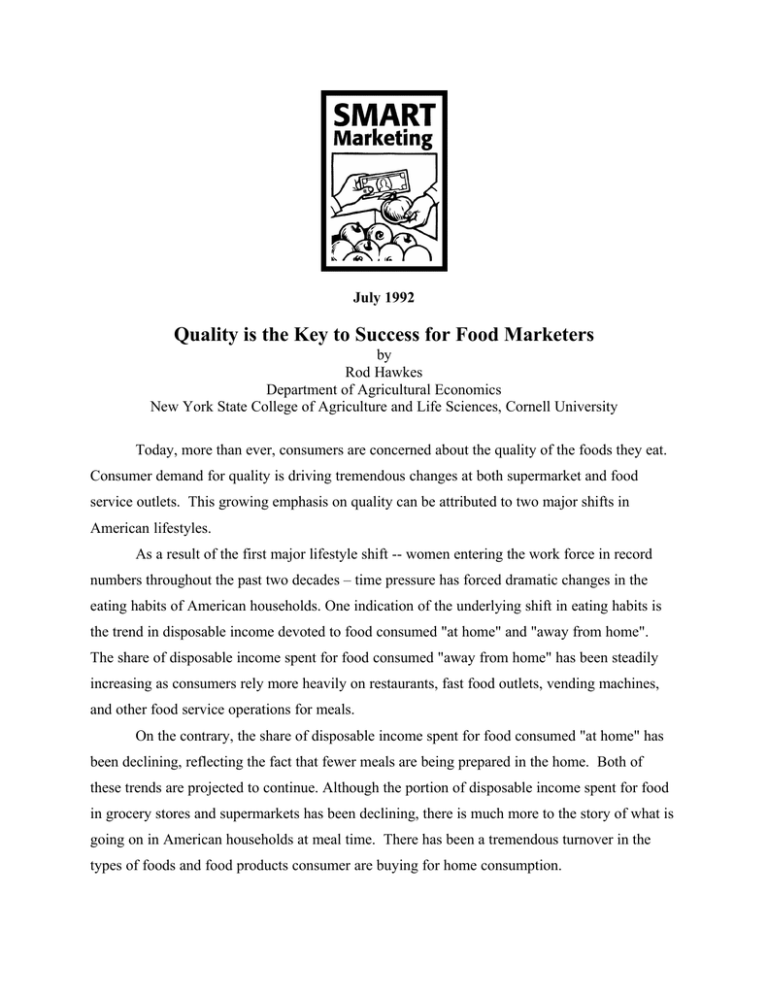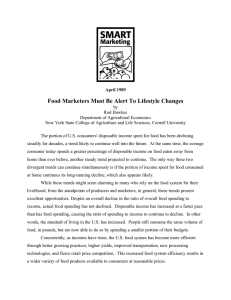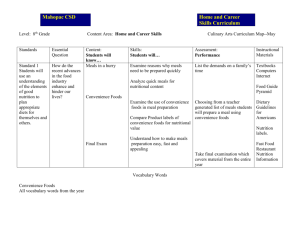Quality is the Key to Success for Food Marketers
advertisement

July 1992 Quality is the Key to Success for Food Marketers by Rod Hawkes Department of Agricultural Economics New York State College of Agriculture and Life Sciences, Cornell University Today, more than ever, consumers are concerned about the quality of the foods they eat. Consumer demand for quality is driving tremendous changes at both supermarket and food service outlets. This growing emphasis on quality can be attributed to two major shifts in American lifestyles. As a result of the first major lifestyle shift -- women entering the work force in record numbers throughout the past two decades – time pressure has forced dramatic changes in the eating habits of American households. One indication of the underlying shift in eating habits is the trend in disposable income devoted to food consumed "at home" and "away from home". The share of disposable income spent for food consumed "away from home" has been steadily increasing as consumers rely more heavily on restaurants, fast food outlets, vending machines, and other food service operations for meals. On the contrary, the share of disposable income spent for food consumed "at home" has been declining, reflecting the fact that fewer meals are being prepared in the home. Both of these trends are projected to continue. Although the portion of disposable income spent for food in grocery stores and supermarkets has been declining, there is much more to the story of what is going on in American households at meal time. There has been a tremendous turnover in the types of foods and food products consumer are buying for home consumption. While fewer and fewer meals are eaten at home, those meals that are consumed at home have drastically changed. Many meals consumed at home rely heavily on components that are prepared outside the home and simply heated (or reheated) at home, often in microwave ovens. Food manufacturers and retailers have responded to consumer demand by offering a wide and expanding variety of products designed specifically for microwave preparation. Supermarkets have further responded by offering convenient hot and cold foods prepared on site in the retail store in ready-to-eat or reheat form. The second, concurrent lifestyle shift -- overall concern about and awareness of health and nutrition -- is also changing American eating habits. Consumers are demanding safe, healthful, nutritious foods and supermarkets and manufacturers are responding with a full range of products and services. Supermarkets have expanded fresh produce, seafood, bakery, natural foods, and salad bar offerings. Food manufacturers now offer healthier alternatives to prepared foods featuring low calorie, low cholesterol, low fat, no fat, and other health oriented formulations. One implication of these lifestyle changes is that consumers must rely more heavily than ever on others for the quality of the food they eat. Food quality is a concept that encompasses elements of nutrition, palatability, safety, appearance, and healthfulness. Of these elements, appearance is often the criteria by which consumers judge the other elements of quality. Therefore, it is paramount for smart marketers of food -- from farmers to grocers -- to ensure their products offer the highest quality possible to meet the demands of today's and tomorrow's consumer.




